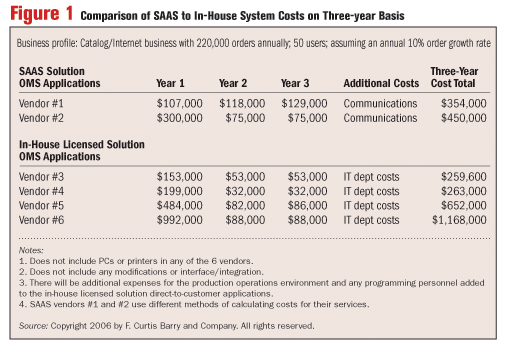This is the second of a two-part series. Last week, we addressed the benefits of the SAAS model. This week, Barry will focus on cost comparisons between OMS and software as a service (SAAS) systems and determining which software is right for you.
Technology has radically changed the options that are open to multichannel companies as they look at acquiring new OMS functionality. Literally hundreds of companies now use SAAS and ASPs; they have become comfortable with giving up control of the IT management and environment.

The inhouse licensed examples should include the costs of managing the IT environment. For small businesses (less than $5 million sales), a technology literate administrative person may also be the “systems administrator. Nowadays, we would expect a business of this size (220,000 orders) to have an IT manager, one full-time programmer, and one operator managing operations and the help desk. Considering payroll, taxes and benefits this may add $150,000 to $225,000 annually to the In-house licensed OMS solutions in Figure 1. Given these increased IT department costs, the in-house option becomes more expensive than the SAAS.
We believe that inhouse licensed, direct-to-customer software vendors #3 and #4 can provide the application adequately. Vendors #5 and #6 are more highly developed systems.
Regardless of the vendors listed on the chart, each company must carefully determine whether licensed products and an inhouse installation or SAAS (or ASP) will best fit the management style and required functionality. Here’s some things to consider:
- What are your requirements? Do your homework. Write the user requirements. Do a head-to-head comparison and match up the vendor responses to your requirements.
- How much customization is desired, as opposed to required? SAAS vendors generally do not want to customize their system unless it benefits the wider user community. An inhouse installation may allow you to develop individual functionality that is more appropriate to your business or more capable of catering to what management wants. But vendors may have different philosophies.
- Reporting and analysis. In today’s world, SAAS are capable and willing to integrate with other commercial systems and to allow implementation of user-friendly report languages such as Crystal or other ODBC-compliant languages.
- Expense vs asset: SAAS expenses are a monthly expense. Whereas in purchasing and implementing a licensed product, the initial implementation of the hardware, software, and training can generally be depreciated and amortized over five years or longer.
- Get comfortable with change in control. With SAAS, the company doesn’t have the inhouse and direct control over the system, data, security, fail over, disaster recovery, and compliance with regulatory agencies and other providers (e.g., credit card PCI compliance, Sarbanes-Oxley compliance). Check this out with user references.
- Investigate release updates. Talk to SAAS customers and determine their track record for quality assurance and testing.
Curt Barry is president of Richmond, VA-based operations consultancy F. Curtis Barry & Company.
